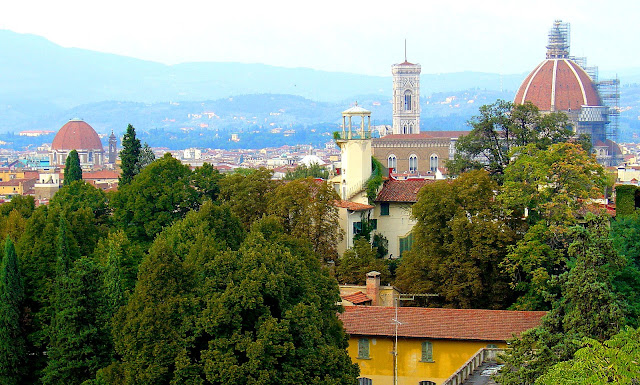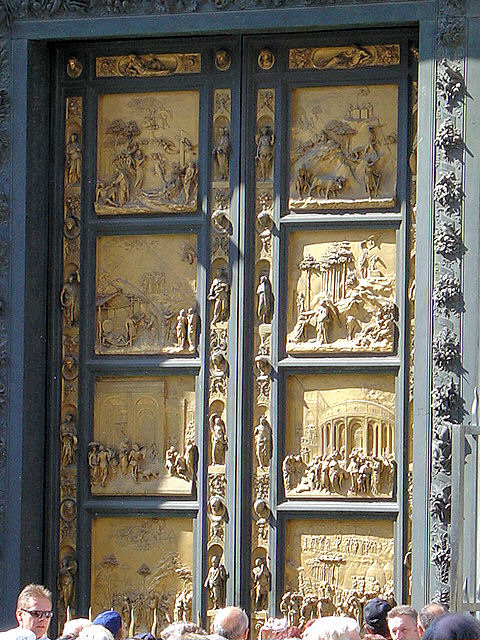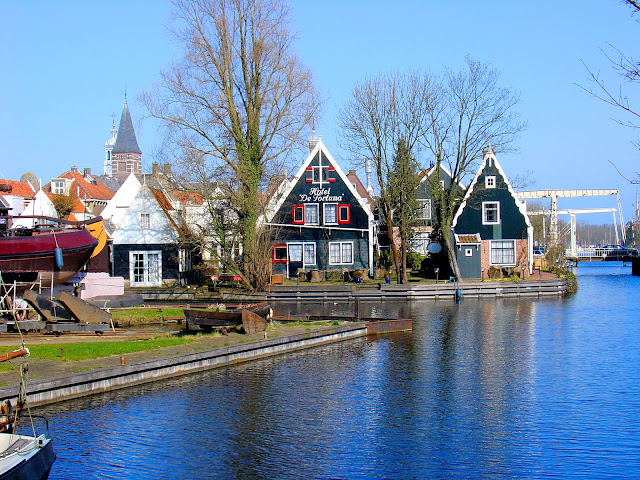ArtOdysseys - The Early Italian Renaissance
 |
| Florence, Italy—Birthplace of the Italian Renaissance. All content is the property of EuroTravelogue™ unless noted. Unauthorized use is prohibited. |
Welcome to the ArtSmart Roundtable—a company of travel bloggers who seek out art while traveling around the world. Each month, we publish a feature on a particular subject with our personal reflection of those experiences encountered along the way. This month, we are thrilled to announce our newest member of the ArtSmart Roundtable Lesley Peterson of CultureTripper.com aka @culturetripper on Twitter. And, at the end of this article, you'll find links to all the other members' features as well.
Our topic for September is "Favorite Art Movement" and so I bring to you, my love of the Renaissance. Born in Italy during the late 14th century, the Italian Renaissance became the defining epoch that would alter the course of history forever; a movement that gave birth to some of the greatest artists of all time from Ghiberti, Masaccio and Donatello in the early Renaissance; to Michelangelo, Leonardo and Raphael in the High Renaissance. While most of us are quite familiar with the artists of the High Renaissance and their masterpieces, we often overlook those who were at the vanguard of this period of enlightenment. This article is going to be a review of some of those pioneers in sculpture, architecture and fresco, and the legacies they left behind. Join me as we walk along in the footsteps of some of the masters of the early Renaissance in Florence, Italy.
A new age of enlightenment—the Renaissance
 |
| Unmistakable Florentine Skyline. |
From the ashes of the Roman Empire through the darkness of the Middle Ages, the dawn of a new era was on the horizon—the Renaissance—the revival of the classical traditions of ancient Rome and Greece. This reawakening produced an explosion of creativity, ingenuity and economic prosperity that would reign from 1390 to 1520; and while each of those elements played an integral role in this period, our focus is on the artists of the day and how their contributions turned darkness into light. Renaissance art transformed 2-D works of the Gothic era into 3-D masterpieces with the introduction of linear perspective. Also, human anatomy was represented in staggering lifelike details leading the way for the first free-standing male nude since Antiquity—Donatello's "David." And let's not forget the advances in architecture, specifically with Brunelleschi's Dome, the world's largest brick and mortar dome, even to this day!
But what drove this radical new thinking and where did it all begin?
Well, one of the leading factors responsible for this transformation into art imitating life in Renaissance art was due to a relatively new philosophy of the time—an ideal embraced by the people—"Humanism." To become aware, understand and capture the human experience, and then translate that through personal forms of expression, was the ultimate goal of Humanism; in other words, keeping all "real" and relative to the people.
The Italian Renaissance primarily began in one of my favorite cities in the world—Florence, Italy. Why Italy? It was because of the Italians' access to the abundant classic artifacts from the days of the Roman Empire that were scattered throughout the country and served as reminders of a greater time.
Early Pioneers of the Italian Renaissance
Let's explore a few of the contributions that led the way of enlightenment—the Renaissance— the new age of thinking, a new dawn of greatness!
Brunelleshi's Dome within a Dome
 |
| Brunelleshi's Dome within a Dome was the product of the Renaissance state of mind and truly groundbreaking in its design. |
No picture or image of the Florentine skyline would be complete without it—the Dome of Santa Maria del Fiore—designed and built by the visionary Filippo Brunelleschi and completed in 1436. The result of a contest won by Brunelleschi over his opponent Ghiberti, the Dome had to be designed in a way that would not contain flying buttresses often shunned by the Italians, and that would span 42 meters (140 feet) to cap off the "new" Florence Duomo. With the support of Cosimo de Medici, Brunelleschi presented his "dome within a dome" design that would not only eliminate the need for flying buttresses but also exterior scaffolding to build it. This bold new concept started with an internal dome constructed of lightweight materials which would then provide the necessary support to complete the outer shell composed of more weather resistant materials. Overall, this would be the first octagonal dome ever built and because the recipe for concrete had been lost since the age of the Pantheon, Brunelleschi would have to build his dome with bricks and mortar, hence, the world record I mentioned above.
Ghiberti's "Gates of Paradise"
 |
| Saint John's Baptistery in Florence and Ghiberti's "Gates of Paradise" on its eastern facade. |
 |
| Ghiberti's "Gates of Paradise" panels depict 10 scenes from the Old Testament. |
Any visit to Florence, Italy, without seeing Ghiberti's "Gates of Paradise," would surely be missing out on one of the finest examples of early Renaissance art. Adorning the eastern doors to Saint John's Baptistery, opposite to the front entrance of the Duomo and where all the tourists are buzzing like bees to a hive, you'll find 10 effulgent bronze panels depicting scenes from the Old Testament. While Ghiberti may have lost the competition of the dome to Brunelleschi, he was the victor of a similar contest to decorate the eastern doors of the Baptistery. Completed in 1452, the bronze panels are a tribute to works of the early Renaissance and to Ghiberti’s mastery of relief with a new technique where successive scenes appear simultaneously within the same panel with applied perspective, which as I mentioned above, was a relatively new concept introduced by none other than Brunelleschi. Look closely in the "Jacob and Esau" panel, you’ll find Ghiberti sculpted his self-portrait—a balding man at age 60, and signed it as well.
 |
| Close-up view of the original "Esau and Jacob" panel of the Ghiberti's "Gates of Paradise." |
Masaccio's "The Trinity"
 |
| Masaccio's "The Trinity." This photo only: WikiMedia.org. |
One of my all-time favorite frescoes can be found at Santa Maria Novella in Florence—Masaccio's "The Trinity" completed in 1428. This 22-foot-tall fresco exemplifies Masaccio's mastery of perspective, the very same linear perspective rules introduced by Brunelleschi. This composition conveys a number of planes at which the subjects reside and to achieve the depth of the chapel pictured here, Masaccio applies his use of orthogonals (diagonal lines receding into the distance) to suggest the depth between the planes with a well-defined vanishing point (where all of the orthogonals converge in most illustrations—think railroad tracks vanishing into the horizon).
The subject matter is the Holy Trinity: the Father in the background, the crucified Jesus Christ in the foreground, and the Holy Spirit—a dove pictured between the heads of the Father and Jesus, and easily mistaken as the white collar of a tunic. At the same plane of Jesus, stand the Madonna to the left and Saint John to the right, while outside the chapel and in the immediate foreground, are the kneeling patrons of this particular commission.
But what I love most about Masaccio's "Holy Trinity" is the "space" in which the Father resides…look very carefully and you will see that He occupies two planes of existence concurrently. While most of His body resides at the farthest plane or background of the chapel; His head, hands and feet occupy the same plane as Jesus. Irrational? No, not according to Masaccio. So why would he paint in this fashion? He painted this to communicate that the Father is a deity who can occupy all planes of existence at the same time and not be confined by the physical properties of the chapel. I find this very concept so compelling and profoundly moving, unlike anything I've encountered in art history. And of the all the pieces I have studied, this ranks near the top of having the greatest impact on me!
 |
| Close-up view of Masaccio's "The Trinity" shows the Father existing on multiple planes at the same time. This photo only: WikiMedia.org. |
These are but a few of the pioneering visionaries who ventured forth into the light of the Early Renaissance. There are many other who are worthy of more study as well. Their contributions became legacies and the very foundation for all of the art that followed. I hope you seek out the masters of the Renaissance on your next journey.
The September ArtSmart Rountable:
- Roman Sculpture from Erin Halvey at A Sense of Place.
- The Pre-Raphaelite Brotherhood from Lesley at CultureTripper.com.


Tremendous photos, Jeff. They sure don't build them like they used to. A staggering achievement, especially given the technology. I have a soft spot for those early frescoes, wrote a few papers on them and almost fainted from awe when I finally managed to see them in person. Powerful indeed. Thanks for the memories and insight.
ReplyDeleteThx so much Lesley for stopping by and for sharing your experiences...you must be a Renaissance Woman yourself. I could have written a book with all the topics I introduced in this post...but I don't think I would have published in time for the Roundtable. Thx again my friend!
DeleteJeff, I just put a few articles about the furniture of the Renaissance on my website which might interest you. www.elegantetruria.com Antiques pages.
ReplyDeleteWow, thank you so much. I will need to check that out my friend.
DeleteAmazing art of the Renaissance. These artists were absolutely brilliant. I'm totally captivated by the photo of Brunelleshi's Dome within a Dome. I would certainly be in awe to see it in person. Very interesting commentary and photos.
ReplyDeleteThank you so much Cathy for stopping by and for your kind words. I totally agree with everything you've said about these Renaissance visionaries! Thx again.
DeleteThat first photo is dreamy. As you know, this is one of my favorite time periods in history, and you did a wonderful job highlighting some of the innovative art works and describing their importance. A great read, Jeff, and a great addition to our ArtSmart series to show people great art around the world!
ReplyDeleteHi there Jenna my Renaissance BFF!!! Thank you so very much for your kind compliments and encouraging words. Love your "dreamy" expression...I dream of Florence often! Thanks again for stopping by to share your thoughts!
DeleteTo me, the most beautiful aspect of Masaccio's Holy Trinity is the color scheme. The patron,Signor Lenzi, and St. John are both dressed in red and Signora Lenzi and Mary are in blue while God's robes are both red and blue as are the coffers of the ceiling which alternate red and blue. Here we have the visual indication that God embraces both the male and female principles. You will also see that Piero della Francesca and other Renaissance painters drape God in both red and blue, probably as an allusion to Masaccio's figure of God in the Holy Trinity. The fresco also shows us the hierarchy where the mortal patrons are lower and not in the same space as Christ who is below the dove or Holy Spirit and God. It is a MUST SEE work of Renaissance art!
ReplyDeleteVirginia Fabbri Butera, Ph.D. Prof. of Art History and Director of the Therese A. Maloney Art Gallery at the College of Saint Elizabeth, Morristown, NJ
Hi Virginia and thank YOU for all of this insightful feedback. It really adds to the overall experience of this post and some of the points you mentioned above, I was not aware of! Wow! I am even more moved by this image thanks to you! I really appreciate you taking the time to share your expertise with my readers! It is feedback like this that I welcome and cherish because it adds even more value and credibility for my readers, who are my number #1 priority! Thank you again!
DeleteWe are so fortunate to still get to appreciate these works of art.
ReplyDeleteHi Marlys! I couldn't agree with you more. Thank God that works such as these have been preserved for all future generations to enjoy! Thx so much for stopping by and sharing your thoughts!
DeleteRenaissance art is truly remarkable. When I moved to Italy, I was so inquisitive to learn about the roots and history of Florence. I read a great book called 'The Medici' by Paul Strathern which gives a really interesting insight to how the Medici family supported the birth of the renaissance movement and the lives of great artists such as Leonardo, Michelangelo and Donatello, as well as scientists like Galileo and Pico della Mirandola.
ReplyDeleteAlso, If there anyone is interested in Roman art history, there is a great 3-part documentary on BBC4 that started yesterday.
Hi there Nathalie and thanks so much for sharing your wisdom! I could have written pages about the Medici but my article was getting too long. But you're right, because the Medici embraced arts and culture and thus funded so many of the commissions we see today, they are an integral part of the birth of the Renaissance and most definitely deserving of a honorable mention. Thank you for stopping by and for your tips on the BBC as well!
DeleteI have to say, I've always been a fan of the Doors of Paradise. I love to mirroring of poses and lines from OT to NT as a visual representation of biblical exegesis. I saw copies on display at the High Museum about 6 years ago.
ReplyDeleteAlso, how did I never learn about that Massacio fresco? It's a mishmash of medieval and Renaissance.
Hi there Erin and thanks so much for your comments. I too am big fan of Gates of Paradise and have been ever since I first saw them in Florence. Your observations about Massacio are 100% correct...he was one of the pioneers who took us from Medieval to the Renaissance. Thx so much for stopping by and sharing your thoughts and experiences!
DeleteJeff, What a beautiful piece of writing about the Renaissance history and arts. Very concise and coherent I love Florence and its Renaissance architecture especially, the Doumo. Yes, I'm in awe of the double dome! I must admit I didn't pay that much attention to The Trinity in Santa Maria Novella. Your piece about it is so profound that I want to go back and look at it closely.
ReplyDeleteHi there Marisol,
DeleteThank you so much for stopping by and for your kind compliments! Actually, I am in awe of the entire city...there is so much to discover and savor!!
Wow Jeff, you read my mind. We were discussing renaissance art only just the other day and how the Medici's embraced the movement through undying sponsorship and passion. Reading a lot of history of that period has made me follow geniuses such as Di Vinci and how he ended up in Milan, working for the Sforza. What he did in terms of city engineering and warfare advisory as well as his well-known art. It's great to follow the trail of these renowned figures and what impact they left in various parts of Italy.
ReplyDeleteHi there Nathalie and thanks so much for stopping by to share your comments! I couldn't agree with you more about the Medici and Leonardo. Actually, could have written a book about the Medici and their influence on the Renaissance for this post but you would probably still be reading it. ; )
Deletenice
ReplyDeleteHi Angelie and thanks for stopping by and for your kind thoughts!
Delete